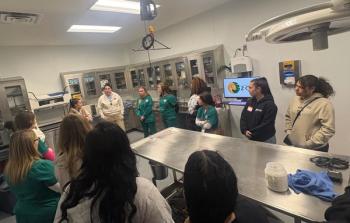
Urinalysis: a step by step approach (Proceedings)
Perform urinalysis within 30 minutes of collection or refrigerate. Allow urine to warm up to room temperature before analysis if it has been refrigerated.
Collection
Always record the method of collection as it is important in interpretation of results
Midstream catch (voided sample)
- Advantages: no risk to the patient and owners can collect it.
- Disadvantages: contamination with cells, bacteria, and other debris located in the genital tract, or on the skin and hair, and the patient doesn't always cooperate.
Manual expression
- Advantages: little risk and ability to collect urine at your convenience as long as there is a full bladder.
- Disadvantages: bladder may not have enough urine or may be difficult to express, possible to traumatize the bladder and cause hematuria, urine is frequently contaminated with cells, bacteria, and other debris located in the genital tract, or on the skin and hair
Catheterization
- Advantages: can collect urine at your convenience and decreases contamination from skin, hair, and genital tract.
- Disadvantages: potential for trauma and hematuria and potential for introducing bacteria into the bladder from the urethra
Cystocentesis
- Advantages: often better tolerated than catheterization, decreased risk of iatrogenic urinary tract infection, prevents contamination of the urine by cells, debris, and bacteria from the lower urogenital tract, and aids in the localization of hematuria, pyuria, or bacteriuria.
- Disadvantages: need adequate urine within the bladder, potential for trauma, and is frequently contaminated with blood.
Handling
Perform urinalysis within 30 minutes of collection or refrigerate. Allow urine to warm up to room temperature before analysis if it has been refrigerated.
A complete urinalysis includes the following:
- Gross observation
- Measurement of solute concentration (specific gravity)
- Measurement of chemical constituents and pH (typically with a dipstick)
- Sedimentation and microscopic evaluation
Gross observation:
Color
- Can be colorless to dark yellow depending on concentration
- Dark yellow to brown may be due to bilirubin
- Red
- Erythrocytes (hematuria)
- Hemoglobin (red to red-brown)
- Myoglobin (reddish brown)
Turbidity / Transparency
- Most species – clear
- Horses – cloudy (calcium carbonate crystals and mucous)
- Cloudiness indicates presence of formed elements
- Microscopic exam should always be used to determine the cause (crystals, cells, mucus, casts, bacteria, spermatozoa). If urine is not evaluated when fresh, crystals may have formed, causing cloudiness
Urine specific gravity (USG)
- Specific gravity is influenced by the number of solute molecules plus molecular size and weight. It's an estimate of the kidney's ability to concentrate or dilute urine.
- Place one drop of urine on the refractometer and read the value directly from the specific gravity scale.
Urine chemistries
The routine chemical analysis is done with commercially-available dipsticks. These sticks contain a battery a test pads, not all of which are useful or reliable in veterinary medicine.
Dip stick
Dip one stick into well-mixed uncentrifuged urine or supernatant from a centrifuged urine sample. The excess urine should be blotted off onto a paper towel by gently tapping the side of the dipstick, holding it horizontally so urine in contact with one test pad doesn't run off onto the pad next to it causing reagents to be mixed. The times at which each pad is read may vary for each test.
pH
Variation between species reflects type of diet. Carnivores tend to have acid urine and herbivores tend to have alkaline urine. It's also affected by diet, infections, handling, and acid-base balance
Glucose
- If serum glucose levels exceed the capacity of the tubules to reabsorb glucose, glucose will be present in the urine.
- Renal thresholds (the concentration of serum glucose that exceeds the renal tubules' reabsorptive capacity and where glucose is first seen in the urine)
- Renal threshold for dog and cat >180 mg/dl
Ketones
If ketonuria is present, this means that ketone concentrations are increased in the blood, but ketonuria is often detectable before ketonemia is apparent. Ketonuria occurs from deficient carbohydrate metabolism and increased fat metabolism (negative energy balance)
Bilirubin
- Not normally detected except in some dogs as they have a low renal threshold and bilirubinura may preceed hyperbilirubinemia.
- Bilirubinuria is always significant in cats
- The most common cause of bilirubinuria is cholestasis.
- Bilirubinuria can also occur with intravascular hemolysis because there can be conversion of hemoglobin to conjugated bilirubin by the tubular epithelial cells.
Blood
- A positive reaction on the dipstick indicates either RBCs (hemorrhage or inflammation), hemoglobin (intravascular hemolysis), or myoglobin (muscle necrosis). Urine test strips can't differentiate these three.
- If the cause is not clinically evident, tests can be done to differentiate between hemoglobin and myoglobin:
- Examine the color of the animal's serum or plasma.
- Myoglobin is freely filtered by the kidneys and hemoglobin is not, therefore if the serum/plasma is red, hemoglobin is present.
- Precipitate out hemoglobin with ammonium sulfate (not a great test).
Protein
- Trace and 1+ results for protein are often seen in concentrated dog and cat urine using urine test strips. Urine protein should be interpreted with knowledge of the urine specific gravity and findings in urine sediment. If there is evidence of inflammation on the sediment exam, the protein can be attributed to this. If you suspect there is protein loss from the kidneys, the inflammation will have to be cleared up before reassessing urine protein content.
- Urine dip sticks are most sensitive for albumin, they will not as accurately detect globulins, Bence Jones proteins, hemoglobin, and mucoproteins.
- False positives for protein can occur on a dipstick in alkaline urine, and a sulfosalicylic acid (SSA) test should be performed when the urine is alkaline.
- In the SSA test, urine protein is precipitated, resulting in a turbidity that is proportional to the quantity of protein present. A 3-5% solution of sulfosalicylic acid is mixed with an equal volume of urine, and the resultant degree of precipitation is graded from trace to 4+. This is used to confirm that a positive reading on a test strip in alkaline urine is really due to protein in the urine.
- The dipstick and SSA are at best, semi-quantitative tests for proteinuria. The urine protein:creatinine ratio (UPC), performed on a single urine specimen is a sensitive, accurate diagnostic technique for detection and quantitation of proteinuria.
- Protein and creatinine concentrations are measured in a single urine sample and the ratio is determined. The normal ratio is <1. The amount of protein is compared to creatinine since creatinine is excreted at a constant rate and the amount of protein in the urine should always be less than creatinine. Since changes in the concentration of urine will affect both protein and creatinine equally, the ratio remains constant whether the urine is concentrated or dilute.
Causes of proteinuria can be either physiologic or pathologic and pathologic can be urinary or non-urinary in origin.
Pre-glomerular
- Physiologic (strenuous exercise, extreme heat or cold, stress, fever, seizures, venous congestion)
- Overload (immunoglobulin fragments, hemoglobin, myoglobin)
Glomerular
Post-glomerular
- Renal tubular dysfunction
- Inflammation
- Significant hemorrhage
Urine sediment
- Centrifuge 5-10 ml (try to consistently centrifuge the same amount) of urine in a conical centrifuge tube for 5 minutes at approximately 2000 rpm. Decant the supernatant into another container leaving approximately 0.5 ml of urine in the tube.
- Mix the urine sediment by flicking the bottom of the tube, then place a drop on a slide and cover with a coverslip. Examine under the microscope with the condenser racked down and low light. If a sediment stain is used, it's highly recommended that an unstained slide also be examined. A drop of stain is added to the drop of urine sediment and it's then covered with a coverslip.
- Scan area on low power (10X) looking for casts. Report the average number per low power field and identify them (e.g. finely granular, hyaline, etc.)
- Go to high dry (40X) and examine then report the average number per field of RBC's, WBC's, crystals, epithelial cells (squamous or transitional), and bacteria. Other findings include fat droplets, sperm, etc.
- To confirm the presence of bacteria if there is a question, remove the cover slip, allow the slide to dry, then stain with Dif-Quick or gram stain.
o RBCs–less than 5/HPF is normal
o WBCs–less than 5/HPF is normal
o Epithelial Cells
• Transitional epithelial cells-from the renal pelvis to the proximal urethra.
• Squamous epithelial cells-from the distal urinary tract.
Casts
Casts are long, oval to rectangular objects, formed in tubular lumens and made of mucoprotein secreted by tubular cells plus cellular material or whatever is present when they're formed.
Types of casts:
- Cellular casts (can be fatty, especially in cats)
o Renal epithelial cells – degeneration of epithelium
- Erythrocyte casts
o Indicate hemorrhage and/or inflammation in kidney
- Leukocyte casts
o Indicate inflammation in the kidney(s)
- Granular – mixture of protein and cellular debris
o Indicate degenerative processes in tubules
• Waxy – advanced stage of granular casts
• Hyaline – all protein (Tamm-Horsfall mucoprotein, secreted by kidney)
o Nonspecific – can occur with high fever or transient hypoxia
o A few (less than 1-2 per LPF) hyaline or granular casts can be seen in concentrated urine of normal animals.
Crystals
- Can be normal or abnormal, depending on the type
- Can form before or after urine collection
- Formation depends on concentration of components and solubility in different pH
- Types of crystals include:
o Magnesium Ammonium Phosphate (Struvite)
• May be found in normal urine sample
• Associated with neutral and alkaline urine
• Can form calculi
o Calcium carbonate
• Frequently found in normal horse urine-no clinical significance
• Formed in alkaline urine
o Urates
• Associated with hepatic disease/PSS, increased in normal Dalmatians
o Ammonium biurate
• Found in slightly acidic, neutral, and alkaline urine
• Yellow/brown
o Amorphous urates
• acidic urine – yellow/brown
o Calcium oxalate
• Acid to alkaline urine
• Dihydrate = common
• Monohydrate = associated with ethylene glycol toxicity
o Cystine
• Hexagonal – formed in acid urine
• Seen with a reabsorptive defect for cystine
o Bilirubin
• Reddish needles or granules
• Can be seen in concentrated dog urine
• High numbers suggests abnormal bilirubin metabolism
o Miscellaneous crystals
• Needle-shaped crystals may be composed of tyrosine, calcium sulfate, sodium urate, ampicillin, tri-iodated contrast agents
Other findings in urine sediment can include, fat droplets, sperm, bacteria, fungal spores or hyphae (these are contaminants-you see them if urine is kept too long), and parasites.
Newsletter
From exam room tips to practice management insights, get trusted veterinary news delivered straight to your inbox—subscribe to dvm360.






